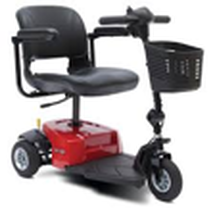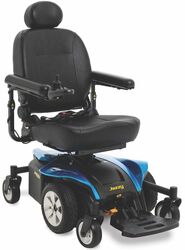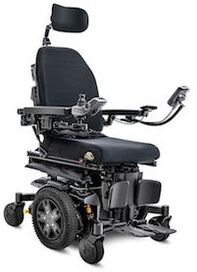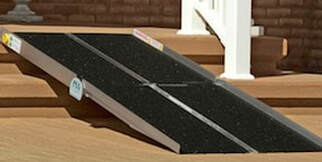Power Wheelchairs for ALS |
|
If you have significantly limited physical mobility, the following motorized devices can provide greater freedom of movement.
Medicare will pay for only one power mobility device every five years, so it is extremely important that you plan strategically if you may need the $20,000+ high-end power chair. Read payment details for each device carefully.
Medicare will pay for only one power mobility device every five years, so it is extremely important that you plan strategically if you may need the $20,000+ high-end power chair. Read payment details for each device carefully.
Three- or four-wheeled scooter
|
These motorized scooters are similar to what you might see at the supermarket. They have a seat with armrests, a base for your feet, handlebars out front, forward/reverse directions, and speed controls. They are operated by hand controls.
Scooters are very helpful for moving from place to place, but they lack support and are not meant for prolonged periods of sitting. Three-wheeled scooters weigh roughly 75 pounds. They can be broken down into pieces to fit into your trunk of your car. The heaviest piece weighs about 30 pounds. |
Scooters are technically covered as durable medical equipment by Medicare, Medicaid, and private insurance, BUT you should not attempt to purchase one without discussing with your local ALS organization and clinic team.
The reason is that Medicare will only pay for 80% of one power mobility device (scooter or wheelchair) every five years, so your benefit may be best used for a $20,000+ high-end power wheelchair that you may need in the future. Scooters typically cost between $700 and $1,500.
In order for a power scooter to be covered by Medicare, your doctor must certify that you need it for use inside your home. (Medicare will not pay for equipment that is solely used outside the home.)
The reason is that Medicare will only pay for 80% of one power mobility device (scooter or wheelchair) every five years, so your benefit may be best used for a $20,000+ high-end power wheelchair that you may need in the future. Scooters typically cost between $700 and $1,500.
In order for a power scooter to be covered by Medicare, your doctor must certify that you need it for use inside your home. (Medicare will not pay for equipment that is solely used outside the home.)
Standard power wheelchair
|
These basic power wheelchairs provide more support than scooters, but have limited adjustment possibilities, few electronic features, and no ability to tilt or recline. They are hand-operated with a small joystick.
Standard power wheelchairs are very helpful for moving from place to place, but they lack support and are not meant for prolonged periods of sitting. They weigh about 250 pounds, so you will need a vehicle lift for the back of your car or a handicap-accessible van in order to transport it. |
Standard power wheelchairs are technically covered as durable medical equipment by Medicare, Medicaid, and private insurance, BUT you should not attempt to purchase one without discussing with your local ALS organization and clinic team.
The reason is that Medicare will only pay for 80% of one power mobility device (scooter or wheelchair) every five years, so your benefit may be best used for a $20,000+ high-end power wheelchair that you may need in the future. Standard power wheelchairs typically cost between $700 and $1,500.
In order for a standard power wheelchair to be covered by Medicare, your doctor must certify that you need it for use inside your home. (Medicare will not pay for equipment that is solely used outside the home.)
The reason is that Medicare will only pay for 80% of one power mobility device (scooter or wheelchair) every five years, so your benefit may be best used for a $20,000+ high-end power wheelchair that you may need in the future. Standard power wheelchairs typically cost between $700 and $1,500.
In order for a standard power wheelchair to be covered by Medicare, your doctor must certify that you need it for use inside your home. (Medicare will not pay for equipment that is solely used outside the home.)
|
Sign up for our free newsletter to stay up-to-date on new content, equipment, ALS news, resources, and more.
|
Custom power tilt/recline wheelchair
|
These motorized, high-end wheelchairs (also called complex rehab or Level 3 power chairs) are custom fitted to support your body and postural needs. Their cutting-edge technology—including the tilt/recline feature, power leg rest, alternate driving modes and controls, and integrated Bluetooth® capabilities—can adapt to your evolving needs. You can choose to pay extra for a power-elevating seat. Portable respiratory and communication devices can be mounted or attached.
|
The custom fitting and tilt/recline function of your power wheelchair should allow you to be in it up to 10–12 hours a day, thus allowing you to spend more time around people and less time in bed. The cushioning and recline options increase comfort and help prevent pressure sores on your rear end and back. Custom power wheelchairs are extremely heavy. You will need a vehicle lift for the back of your car or a handicap-accessible van in order to transport it.
|
To learn all about custom power wheelchairs, visit our comprehensive ALS Power Wheelchair Guide.
|
Wheelchair Ramp
|
Wheelchair ramps can help you travel smoothly over steps and thresholds in and around your home. There are many different types of ramps, from permanent concrete ramps to portable ones made from aluminum, wood, or rubber.
Unfortunately, wheelchair ramps are not covered by insurance. We suggest checking with your local ALS organization's loan closet. If you cannot borrow ramps that suit your needs, you may need to purchase ramps. In some cases, you may need to hire a contractor to build custom ramps for specific areas of your home. |








